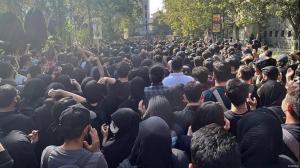
PMOI Resistance Units across the country are commemorating the event in 2022 of up and its martyrs with acts of defiance and messages of resistance. These acts are happening despite the growing repressive measures by the regime, especially against the PMOI.
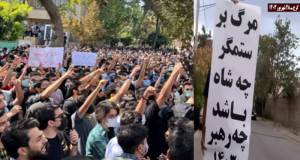
In Karaj, Resistance Units held banners with the slogan “Down with the oppressor, be it the Shah or the mullahs.” This is one of the popular slogans of the 2022 uprising, underlining the Iranian people’s rejection of any kind of dictatorship.
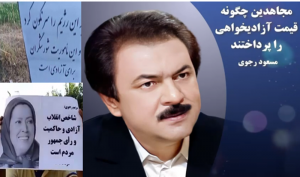
In several cities, Resistance Units installed posters of Iranian Resistance leader Massoud Rajavi along with messages of resistance such as “Rebels never surrender” and “The democratic revolution of the people of Iran will be victorious.”
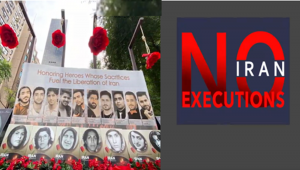
To end executions in Iran, the country’s rebellious youth targeted the regime’s centers of crime and oppression in various cities in response to the recent wave of executions, including 264 executions since the beginning of the presidency of Massoud Pezeshkian.
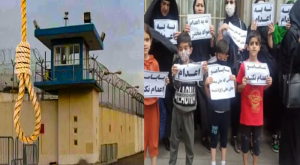
On the occasion of the World Day Against the Death Penalty, a group of political prisoners in Ghezel Hesar Prison wrote in a message: “Under the religious dictatorship ruling Iran, the working class, especially prisoners, endure double suffering.
As part of this campaign, 1,500 prominent figures from 78 countries across five continents have supported the global “No to Execution” movement in Iran. The regime responded with repression and violence, arresting, beating, and killing protesters in 2022. More than 750 protesters were murdered by security forces and several thousand were arrested.”
— MEK PARIS, FRANCE, October 14, 2024 /EINPresswire.com/ -- The official website of the People’s Mojahedin Organization of Iran (PMOI/MEK) in an article published that as Iran marks the second anniversary of the 2022 uprising, PMOI Resistance Units across the country are commemorating the event and its martyrs with acts of defiance and messages of resistance. These acts are happening despite the growing repressive measures by the regime, especially against the PMOI.
The Resistance Units are a network of activists who play an important role in shaping protests inside Iran and have become a serious problem for the regime.
In Karaj, Resistance Units held banners with the slogan “Down with the oppressor, be it the Shah or the mullahs.” This is one of the popular slogans of the 2022 uprising, underlining the Iranian people’s rejection of any kind of dictatorship.
In several cities, the Resistance Units marked the second anniversary of the uprising by holding photos of the martyrs, murdered by the regime.
In Amol, a member of the Resistance Units held up images of youth executed by the regime for taking part in the protests along with the written message:
“Like the Shah, the mullahs’ regime will be overthrown.” In Tehran, they held images of Mohsen Shekari and Hamidreza Rouhi, two of the martyrs.
In many cities, the Resistance Units held up signs with the slogan “Woman Resistance Freedom,” one of the popular slogans of the uprising honoring the leading role of women in the fight against tyranny and for the establishment of freedom.
In several cities, Resistance Units installed posters of Iranian Resistance leader Massoud Rajavi along with messages of resistance such as “Rebels never surrender” and “The democratic revolution of the people of Iran will be victorious.”
Mahsa (Zhina) Amini, a 22-year-old woman, was arrested on Tuesday, September 13, 2022, in Tehran by the regime’s so-called “Guidance Patrol” and transferred to the “Moral Security” agency.
Amini was severely beaten by the security forces. She later lost consciousness due to her wounds and was transferred to the capital’s Kasra Hospital, where she entered a state of coma that continued until her death on September 16.
Amini’s death triggered protests in Tehran, her hometown Saqqez, and other cities. The protests quickly turned into a nationwide movement against the regime’s repression of freedoms. Protesters called for the overthrow of the regime.
The regime responded with repression and violence, arresting, beating, and killing protesters. More than 750 protesters were murdered by security forces and several thousand were arrested.
The 2022 nationwide uprising further solidified the regime’s perception of the PMOI as an existential threat. Despite the arrest or disappearance of over 3,600 Resistance Unit members, their influence continued to grow.
This resilience in the face of severe repression demonstrated the deep-rooted support for the PMOI within Iranian society.
The regime has engaged in a campaign to dissuade Iran’s youth from joining the PMOI network. Its efforts include widespread misinformation and demonization campaigns along with repressive measures including arrests, long prison terms, and even death sentences . However, the Resistance Units continue to expand every day, carrying on the legacy of Iran’s uprisings and preparing the grounds for the next.
Simultaneously with the global campaign to end executions in Iran, the country’s rebellious youth targeted the regime’s centers of crime and oppression in various cities in response to the recent wave of executions, including 264 executions since the beginning of the presidency of Massoud Pezeshkian.
The fiery response of the rebellious youth took place on October 10, in tandem with the World Day Against the Death Penalty:
Explosions at the judiciary building in Shiraz, the disciplinary office in Arak, the so-called Revolutionary Court in Harsin, the General Directorate of Prisons in Kerman, the intelligence police in Qazvin, the executive headquarters and corrupt Khomeini foundation in Tehran and Kerman, and regime buildings in Yasuj.
The rebellious youth in Fahraj, Kerman, threw Molotov cocktails at an IRGC Basij base tasked with suppressing women, and in Zahedan, they attacked the headquarters of the IRGC’s intelligence and espionage unit as well as a Basij base.
In Tehran, they set fire to a Basij base and torched banners of former regime president Ebrahim Raisi, known as the “Executioner of Tehran. In Yasuj, one of the regime’s centers of fundamentalism was targeted.
In Mashhad, the youth set fire to the regime’s propaganda banners celebrating the Iran-Iraq war, and in Tehran, they torched a banner of Hassan Nasrallah, the now-dead leader of the Tehran-backed Hezbollah.
Through these activities, the rebellious youth reflect the sentiment of the Iranian people, who have made it clear that they do not stand behind the regime’s warmongering efforts and its terrorist proxies.
On the occasion of the World Day Against the Death Penalty, a group of political prisoners in Ghezel Hesar Prison wrote in a message: “Under the religious dictatorship ruling Iran, the working class, especially prisoners, endure double suffering.
Prisoners who are themselves victims of the regime’s expansionist policies live as if this is the end of the world, deprived of even the most basic legal rights. Yes, in the eyes of the rulers and their jailers, prisoners have no rights.
Prisoners’ lives are taken as easily as drinking water, and unjust death sentences are issued in sham trials without the right to defense. Every week, some of our fellow inmates are handed over to the gallows, while others spend the night under the shadow of the noose, haunted by the nightmare of death. These are the most agonizing moments of our lives and those of our families.”
In another part of the statement from prisoners in Ghezel Hesar, it reads: “For more than 37 weeks, prisoners in 22 prisons have launched a broad campaign against executions, staging strikes on Tuesdays to bring the voice of Iranian prisoners to the world.
On the eve of the World Day Against the Death Penalty, we call on the people of Iran, the awakened consciences of humanity, Amnesty International, and the UN Human Rights Committee to hear our voices and work to abolish the death penalty, putting pressure on the Iranian rulers to cancel these unjust execution orders.”
Yesterday, in this column, we wrote: “The support of figures, parliaments, human rights organizations, and free Iranians across the globe for the prisoners’ protest in the ‘No to Execution Tuesdays’ campaign has extended the “No to Execution’ movement beyond Iran’s borders, awakening the conscience of the world to stand with the prisoners and their campaign.”
As part of this campaign, 1,500 prominent figures from 78 countries across five continents have supported the global “No to Execution” movement in Iran.
Among the signatories are 34 former presidents and prime ministers, 59 former ministers, 93 former UN reporters and ambassadors, 102 international judges and legal experts, 109 leading human rights experts, and 46 Nobel laureates.
In addition, 455 members of parliament, 90 mayors, and 85 city council members have signed this statement.
In part of the statement from the signatories of this campaign, it says: “We endorse and support Maryam Rajavi’s call to end executions in Iran and her steadfast commitment to abolishing the death penalty, as outlined in her Ten-Point Plan for Iran’s future over the past two decades. She reaffirmed this call at the International Jurists’ Conference on August 24, 2024, in Paris.”
The statement continues, noting the political motivations behind the brutal executions in Iran: “Iranian authorities are using these executions for political purposes, seeking to instill fear and terror to prevent the potential outbreak of uprisings by the Iranian people. Thus, any execution carried out under the ruling theocracy should be recognized as political.”
Last week, Mrs. Maryam Rajavi, the president-elect of the National Council of Resistance of Iran (NCRI), attended a conference at the Parliamentary Assembly of the Council of Europe, where she called on the international community to support the Iranian Resistance’s “No to Execution” campaign and demanded accountability from the regime’s leaders for genocide and crimes against humanity.
If you wish to receive the NCRI weekly Newsletter, please use the following link to subscribe: https://bit.ly/3SMgEla.
Shahin GobadiNCRI+33 6 61 65 32 31email us here
This resilience in the face of severe repression demonstrated the deep-rooted support for the PMOI within Iranian society.
[embed]https://www.youtube.com/watch?v=rRLIn46qhfA[/embed]
Legal Disclaimer:
EIN Presswire provides this news content "as is" without warranty of any kind. We do not accept any responsibility or liability for the accuracy, content, images, videos, licenses, completeness, legality, or reliability of the information contained in this article. If you have any complaints or copyright issues related to this article, kindly contact the author above.
You just read:
News Provided By
October 14, 2024, 17:57 GMT
EIN Presswire's priority is author transparency. We do our best to weed out false and misleading content. The content above is the sole responsibility of the author who makes it available. If you have any complaints, kindly contact the author above. Article originally published on www.einpresswire.com as (Video) Iran’s rebellious youth respond to regime’s wave of executions






